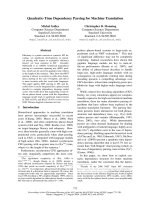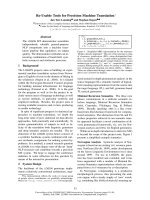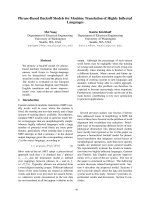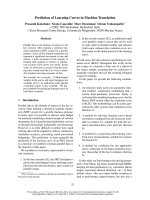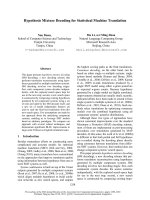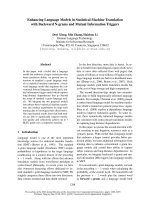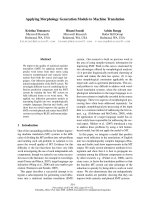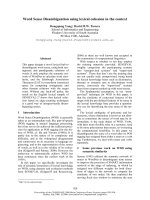Báo cáo khoa học: "Word Sense Disambiguation Improves Statistical Machine Translation" docx
Bạn đang xem bản rút gọn của tài liệu. Xem và tải ngay bản đầy đủ của tài liệu tại đây (505.42 KB, 8 trang )
Proceedings of the 45th Annual Meeting of the Association of Computational Linguistics, pages 33–40,
Prague, Czech Republic, June 2007.
c
2007 Association for Computational Linguistics
Word Sense Disambiguation Improves Statistical Machine Translation
Yee Seng Chan and Hwee Tou Ng
Department of Computer Science
National University of Singapore
3 Science Drive 2
Singapore 117543
{chanys, nght}@comp.nus.edu.sg
David Chiang
Information Sciences Institute
University of Southern California
4676 Admiralty Way, Suite 1001
Marina del Rey, CA 90292, USA
Abstract
Recent research presents conflicting evi-
dence on whether word sense disambigua-
tion (WSD) systems can help to improve the
performance of statistical machine transla-
tion (MT) systems. In this paper, we suc-
cessfully integrate a state-of-the-art WSD
system into a state-of-the-art hierarchical
phrase-based MT system, Hiero. We show
for the first time that integrating a WSD sys-
tem improves the performance of a state-of-
the-art statistical MT system on an actual
translation task. Furthermore, the improve-
ment is statistically significant.
1 Introduction
Many words have multiple meanings, depending on
the context in which they are used. Word sense dis-
ambiguation (WSD) is the task of determining the
correct meaning or sense of a word in context. WSD
is regarded as an important research problem and is
assumed to be helpful for applications such as ma-
chine translation (MT) and information retrieval.
In translation, different senses of a word w in a
source language may have different translations in a
target language, depending on the particular mean-
ing of w in context. Hence, the assumption is that
in resolving sense ambiguity, a WSD system will be
able to help an MT system to determine the correct
translation for an ambiguous word. To determine the
correct sense of a word, WSD systems typically use
a wide array of features that are not limited to the lo-
cal context of w, and some of these features may not
be used by state-of-the-art statistical MT systems.
To perform translation, state-of-the-art MT sys-
tems use a statistical phrase-based approach (Marcu
and Wong, 2002; Koehn et al., 2003; Och and
Ney, 2004) by treating phrases as the basic units
of translation. In this approach, a phrase can be
any sequence of consecutive words and is not nec-
essarily linguistically meaningful. Capitalizing on
the strength of the phrase-based approach, Chiang
(2005) introduced a hierarchical phrase-based sta-
tistical MT system, Hiero, which achieves signifi-
cantly better translation performance than Pharaoh
(Koehn, 2004a), which is a state-of-the-art phrase-
based statistical MT system.
Recently, some researchers investigated whether
performing WSD will help to improve the perfor-
mance of an MT system. Carpuat and Wu (2005)
integrated the translation predictions from a Chinese
WSD system (Carpuat et al., 2004) into a Chinese-
English word-based statistical MT system using the
ISI ReWrite decoder (Germann, 2003). Though they
acknowledged that directly using English transla-
tions as word senses would be ideal, they instead
predicted the HowNet sense of a word and then used
the English gloss of the HowNet sense as the WSD
model’s predicted translation. They did not incor-
porate their WSD model or its predictions into their
translation model; rather, they used the WSD pre-
dictions either to constrain the options available to
their decoder, or to postedit the output of their de-
coder. They reported the negative result that WSD
decreased the performance of MT based on their ex-
periments.
In another work (Vickrey et al., 2005), the WSD
problem was recast as a word translation task. The
33
translation choices for a word w were defined as the
set of words or phrases aligned to w, as gathered
from a word-aligned parallel corpus. The authors
showed that they were able to improve their model’s
accuracy on two simplified translation tasks: word
translation and blank-filling.
Recently, Cabezas and Resnik (2005) experi-
mented with incorporating WSD translations into
Pharaoh, a state-of-the-art phrase-based MT sys-
tem (Koehn et al., 2003). Their WSD system pro-
vided additional translations to the phrase table of
Pharaoh, which fired a new model feature, so that
the decoder could weigh the additional alternative
translations against its own. However, they could
not automatically tune the weight of this feature in
the same way as the others. They obtained a rela-
tively small improvement, and no statistical signifi-
cance test was reported to determine if the improve-
ment was statistically significant.
Note that the experiments in (Carpuat and Wu,
2005) did not use a state-of-the-art MT system,
while the experiments in (Vickrey et al., 2005) were
not done using a full-fledged MT system and the
evaluation was not on how welleach source sentence
was translated as a whole. The relatively small im-
provement reported by Cabezas and Resnik (2005)
without a statistical significance test appears to be
inconclusive. Considering the conflicting results re-
ported by prior work, it is not clear whether a WSD
system can help to improve the performance of a
state-of-the-art statistical MT system.
In this paper, we successfully integrate a state-
of-the-art WSD system into the state-of-the-art hi-
erarchical phrase-based MT system, Hiero (Chiang,
2005). The integration is accomplished by introduc-
ing two additional features into the MT model which
operate on the existing rules of the grammar, with-
out introducing competing rules. These features are
treated, both in feature-weight tuning and in decod-
ing, on the same footing as the rest of the model,
allowing it to weigh the WSD model predictions
against other pieces of evidence so as to optimize
translation accuracy (as measured by BLEU). The
contribution of our work lies in showing for the first
time that integrating a WSD system significantly im-
proves the performance of a state-of-the-art statisti-
cal MT system on an actual translation task.
In the next section, we describe our WSD system.
Then, in Section 3, we describe the Hiero MT sys-
tem and introduce the two new features used to inte-
grate the WSD system into Hiero. In Section 4, we
describe the training data used by the WSD system.
In Section 5, we describe how the WSD translations
provided are used by the decoder of the MT system.
In Section 6 and 7, we present and analyze our ex-
perimental results, before concluding in Section 8.
2 Word Sense Disambiguation
Prior research has shown that using Support Vector
Machines (SVM) as the learning algorithm for WSD
achieves good results (Lee and Ng, 2002). For our
experiments, we use the SVM implementation of
(Chang and Lin, 2001) as it is able to work on multi-
class problems to output the classification probabil-
ity for each class.
Our implemented WSD classifier uses the knowl-
edge sources of local collocations, parts-of-speech
(POS), and surrounding words, following the suc-
cessful approach of (Lee and Ng, 2002). For local
collocations, we use 3 features, w
−1
w
+1
, w
−1
, and
w
+1
, where w
−1
(w
+1
) is the token immediately to
the left (right) of the current ambiguous word oc-
currence w. For parts-of-speech, we use 3 features,
P
−1
, P
0
, and P
+1
, where P
0
is the POS of w, and
P
−1
(P
+1
) is the POS of w
−1
(w
+1
). For surround-
ing words, we consider all unigrams (single words)
in the surrounding context of w. These unigrams can
be in a different sentence from w. We perform fea-
ture selection on surrounding words by including a
unigram only if it occurs 3 or more times in some
sense of w in the training data.
To measure the accuracy of our WSD classifier,
we evaluate it on the test data of SENSEVAL-3 Chi-
nese lexical-sample task. We obtain accuracy that
compares favorably to the best participating system
in the task (Carpuat et al., 2004).
3 Hiero
Hiero (Chiang, 2005) is a hierarchical phrase-based
model for statistical machine translation, based on
weighted synchronous context-free grammar (CFG)
(Lewis and Stearns, 1968). A synchronous CFG
consists of rewrite rules such as the following:
X → γ, α (1)
34
where X is a non-terminal symbol, γ (α) is a string
of terminal and non-terminal symbols in the source
(target) language, and there is a one-to-one corre-
spondence between the non-terminals in γ and α in-
dicated by co-indexation. Hence, γ and α always
have the same number of non-terminal symbols. For
instance, we could have the following grammar rule:
X → X
1
, go to X
1
every month to (2)
where boxed indices represent the correspondences
between non-terminal symbols.
Hiero extracts the synchronous CFG rules auto-
matically from a word-aligned parallel corpus. To
translate a source sentence, the goal is to find its
most probable derivation using the extracted gram-
mar rules. Hiero uses a general log-linear model
(Och and Ney, 2002) where the weight of a deriva-
tion D for a particular source sentence and its trans-
lation is
w(D) =
i
φ
i
(D)
λ
i
(3)
where φ
i
is a feature function and λ
i
is the weight for
feature φ
i
. To ensure efficient decoding, the φ
i
are
subject to certain locality restrictions. Essentially,
they should be defined as products of functions de-
fined on isolated synchronous CGF rules; however,
it is possible to extend the domain of locality of
the features somewhat. A n-gram language model
adds a dependence on (n−1) neighboring target-side
words (Wu, 1996; Chiang, 2007), making decoding
much more difficult but still polynomial; in this pa-
per, we add features that depend on the neighboring
source-side words, which does not affect decoding
complexity at all because the source string is fixed.
In principle we could add features that depend on
arbitrary source-side context.
3.1 New Features in Hiero for WSD
To incorporate WSD into Hiero, we use the trans-
lations proposed by the WSD system to help Hiero
obtain a better or more probable derivation during
the translation of each source sentence. To achieve
this, when a grammar rule R is considered during
decoding, and we recognize that some of the ter-
minal symbols (words) in α are also chosen by the
WSD system as translations for some terminal sym-
bols (words) in γ, we compute the following fea-
tures:
• P
wsd
(t | s) gives the contextual probability of
the WSD classifier choosing t as a translation
for s, where t (s) is some substring of terminal
symbols in α (γ). Because this probability only
applies to some rules, and we don’t want to pe-
nalize those rules, we must add another feature,
• Pty
wsd
= exp(−|t|), where t is the translation
chosen by the WSD system. This feature, with
a negative weight, rewards rules that use trans-
lations suggested by the WSD module.
Note that we can take the negative logarithm of
the rule/derivation weights and think of them as
costs rather than probabilities.
4 Gathering Training Examples for WSD
Our experiments were for Chinese to English trans-
lation. Hence, in the context of our work, a syn-
chronous CFG grammar rule X → γ, α gathered
by Hiero consists of a Chinese portion γ and a cor-
responding English portion α, where each portion is
a sequence of words and non-terminal symbols.
Our WSD classifier suggests a list of English
phrases (where each phrase consists of one or more
English words) with associated contextual probabil-
ities as possible translations for each particular Chi-
nese phrase. In general, the Chinese phrase may
consist of k Chinese words, where k = 1, 2, 3, . .
However, we limit k to 1 or 2 for experiments re-
ported in this paper. Future work can explore en-
larging k.
Whenever Hiero is about to extract a grammar
rule where its Chinese portion is a phrase of one or
two Chinese words with no non-terminal symbols,
we note the location (sentence and token offset) in
the Chinese half of the parallel corpus from which
the Chinese portion of the rule is extracted. The ac-
tual sentence in the corpus containing the Chinese
phrase, and the one sentence before and the one sen-
tence after that actual sentence, will serve as the con-
text for one training example for the Chinese phrase,
with the corresponding English phrase of the gram-
mar rule as its translation. Hence, unlike traditional
WSD where the sense classes are tied to a specific
sense inventory, our “senses” here consist of the En-
glish phrases extracted as translations for each Chi-
nese phrase. Since the extracted training data may
35
be noisy, for each Chinese phrase, we remove En-
glish translations that occur only once. Furthermore,
we only attempt WSD classification for those Chi-
nese phrases with at least 10 training examples.
Using the WSD classifier described in Section 2,
we classified the words in each Chinese source sen-
tence to be translated. We first performed WSD on
all single Chinese words which are either noun, verb,
or adjective. Next, we classified the Chinese phrases
consisting of 2 consecutive Chinese words by simply
treating the phrase as a single unit. When perform-
ing classification, we give as output the set of En-
glish translations with associated context-dependent
probabilities, which are the probabilities of a Chi-
nese word (phrase) translating into each English
phrase, depending on the context of the Chinese
word (phrase). After WSD, the ith word c
i
in every
Chinese sentence may have up to 3 sets of associ-
ated translations provided by the WSD system: a set
of translations for c
i
as a single word, a second set
of translations for c
i−1
c
i
considered as a single unit,
and a third set of translations for c
i
c
i+1
considered
as a single unit.
5 Incorporating WSD during Decoding
The following tasks are done for each rule that is
considered during decoding:
• identify Chinese words to suggest translations
for
• match suggested translations against the En-
glish side of the rule
• compute features for the rule
The WSD system is able to predict translations
only for a subset of Chinese words or phrases.
Hence, we must first identify which parts of the
Chinese side of the rule have suggested translations
available. Here, we consider substrings of length up
to two, and we give priority to longer substrings.
Next, we want to know, for each Chinese sub-
string considered, whether the WSD system sup-
ports the Chinese-English translation represented by
the rule. If the rule is finally chosen as part of the
best derivation for translating the Chinese sentence,
then all the words in the English side of the rule will
appear in the translated English sentence. Hence,
we need to match the translations suggested by the
WSD system against the English side of the rule. It
is for these matching rules that the WSD features
will apply.
The translations proposed by the WSD system
may be more than one word long. In order for a
proposed translation to match the rule, we require
two conditions. First, the proposed translation must
be a substring of the English side of the rule. For
example, the proposed translation “every to” would
not match the chunk “every month to”. Second, the
match must contain at least one aligned Chinese-
English word pair, but we do not make any other
requirements about the alignment of the other Chi-
nese or English words.
1
If there are multiple possi-
ble matches, we choose the longest proposed trans-
lation; in the case of a tie, we choose the proposed
translation with the highest score according to the
WSD model.
Define a chunk of a rule to be a maximal sub-
string of terminal symbols on the English side of the
rule. For example, in Rule (2), the chunks would be
“go to” and “every month to”. Whenever we find
a matching WSD translation, we mark the whole
chunk on the English side as consumed.
Finally, we compute the feature values for the
rule. The feature P
wsd
(t | s) is the sum of the costs
(according to the WSD model) of all the matched
translations, and the feature Pty
wsd
is the sum of
the lengths of all the matched translations.
Figure 1 shows the pseudocode for the rule scor-
ing algorithm in more detail, particularly with re-
gards to resolving conflicts between overlapping
matches. To illustrate the algorithm given in Figure
1, consider Rule (2). Hereafter, we will use symbols
to represent the Chinese and English words in the
rule: c
1
, c
2
, and c
3
will represent the Chinese words
“”, “”, and “” respectively. Similarly, e
1
, e
2
,
e
3
, e
4
, and e
5
will represent the English words go,
to, every, month, and to respectively. Hence, Rule
(2) has two chunks: e
1
e
2
and e
3
e
4
e
5
. When the rule
is extracted from the parallel corpus, it has these
alignments between the words of its Chinese and
English portion: {c
1
–e
3
,c
2
–e
4
,c
3
–e
1
,c
3
–e
2
,c
3
–e
5
},
which means that c
1
is aligned to e
3
, c
2
is aligned to
1
In order to check this requirement, we extended Hiero to
make word alignment information available to the decoder.
36
Input: rule R considered during decoding with its own associated cost
R
L
c
= list of symbols in Chinese portion of R
WSDcost = 0
i = 1
while i ≤ len(L
c
):
c
i
= ith symbol in L
c
if c
i
is a Chinese word (i.e., not a non-terminal symbol):
seenChunk = ∅ // seenChunk is a global variable and is passed by reference to matchWSD
if (c
i
is not the last symbol in L
c
) and (c
i+1
is a terminal symbol): then c
i+1
=(i+1)th symbol in L
c
, else c
i+1
= NULL
if (c
i+1
!=NULL) and (c
i
, c
i+1
) as a single unit has WSD translations:
W SD
c
= set of WSD translations for (c
i
, c
i+1
) as a single unit with context-dependent probabilities
WSDcost = WSDcost + matchWSD(c
i
, W SD
c
, seenChunk)
WSDcost = WSDcost + matchWSD(c
i+1
, W SD
c
, seenChunk)
i = i + 1
else:
W SD
c
= set of WSD translations for c
i
with context-dependent probabilities
WSDcost = WSDcost + matchWSD(c
i
, W SD
c
, seenChunk)
i = i + 1
cost
R
= cost
R
+ WSDcost
matchWSD(c, W SD
c
, seenChunk):
// seenChunk is the set of chunks of R already examined for possible matching WSD translations
cost = 0
ChunkSet = set of chunks in R aligned to c
for chunk
j
in ChunkSet:
if chunk
j
not in seenChunk:
seenChunk = seenChunk ∪ { chunk
j
}
E
chunk
j
= set of English words in chunk
j
aligned to c
Candidate
wsd
= ∅
for wsd
k
in W SD
c
:
if (wsd
k
is sub-sequence of chunk
j
) and (wsd
k
contains at least one word in E
chunk
j
)
Candidate
wsd
= Candidate
wsd
∪ { wsd
k
}
wsd
best
= best matching translation in Candidate
wsd
against chunk
j
cost = cost + costByWSDfeatures(wsd
best
) // costByWSDfeatures sums up the cost of the two WSD features
return cost
Figure 1: WSD translations affecting the cost of a rule R considered during decoding.
e
4
, and c
3
is aligned to e
1
, e
2
, and e
5
. Although all
words are aligned here, in general for a rule, some of
its Chinese or English words may not be associated
with any alignments.
In our experiment, c
1
c
2
as a phrase has a list of
translations proposed by the WSD system, includ-
ing the English phrase “every month”. matchWSD
will first be invoked for c
1
, which is aligned to only
one chunk e
3
e
4
e
5
via its alignment with e
3
. Since
“every month” is a sub-sequence of the chunk and
also contains the word e
3
(“every”), it is noted as
a candidate translation. Later, it is determined that
the most number of words any candidate translation
has is two words. Since among all the 2-word candi-
date translations, the translation “every month” has
the highest translation probability as assigned by the
WSD classifier, it is chosen as the best matching
translation for the chunk. matchWSD is then invoked
for c
2
, which is aligned to only one chunk e
3
e
4
e
5
.
However, since this chunk has already been exam-
ined by c
1
with which it is considered as a phrase, no
further matching is done for c
2
. Next, matchWSD is
invoked for c
3
, which is aligned to both chunks of R.
The English phrases “go to” and “to” are among the
list of translations proposed by the WSD system for
c
3
, and they are eventually chosen as the best match-
ing translations for the chunks e
1
e
2
and e
3
e
4
e
5
, re-
spectively.
6 Experiments
As mentioned, our experiments were on Chinese to
English translation. Similar to (Chiang, 2005), we
trained the Hiero system on the FBIS corpus, used
the NIST MT 2002 evaluation test set as our devel-
opment set to tune the feature weights, and the NIST
MT 2003 evaluation test set as our test data. Using
37
System BLEU-4 Individual n-gram precisions
1 2 3 4
Hiero 29.73 74.73 40.14 21.83 11.93
Hiero+WSD 30.30 74.82 40.40 22.45 12.42
Table 1: BLEU scores
Features
System P
lm
(e) P (γ|α) P(α|γ) P
w
(γ|α) P
w
(α|γ) P ty
phr
Glue Pty
word
P
wsd
(t|s) P ty
wsd
Hiero 0.2337 0.0882 0.1666 0.0393 0.1357 0.0665 −0.0582 −0.4806 - -
Hiero+WSD 0.1937 0.0770 0.1124 0.0487 0.0380 0.0988 −0.0305 −0.1747 0.1051 −0.1611
Table 2: Weights for each feature obtained by MERT training. The first eight features are those used by
Hiero in (Chiang, 2005).
the English portion of the FBIS corpus and the Xin-
hua portion of the Gigaword corpus, we trained a tri-
gram language model using the SRI Language Mod-
elling Toolkit (Stolcke, 2002). Following (Chiang,
2005), we used the version 11a NIST BLEU script
with its default settings to calculate the BLEU scores
(Papineni et al., 2002) based on case-insensitive n-
gram matching, where n is up to 4.
First, we performed word alignment on the FBIS
parallel corpus using GIZA++ (Och and Ney, 2000)
in both directions. The word alignments of both
directions are then combined into a single set of
alignments using the “diag-and” method of Koehn
et al. (2003). Based on these alignments, syn-
chronous CFG rules are then extracted from the cor-
pus. While Hiero is extracting grammar rules, we
gathered WSD training data by following the proce-
dure described in section 4.
6.1 Hiero Results
Using the MT 2002 test set, we ran the minimum-
error rate training (MERT) (Och, 2003) with the
decoder to tune the weights for each feature. The
weights obtained are shown in the row Hiero of
Table 2. Using these weights, we run Hiero’s de-
coder to perform the actual translation of the MT
2003 test sentences and obtained a BLEU score of
29.73, as shown in the row Hiero of Table 1. This is
higher than the score of 28.77 reported in (Chiang,
2005), perhaps due to differences in word segmenta-
tion, etc. Note that comparing with the MT systems
used in (Carpuat and Wu, 2005) and (Cabezas and
Resnik, 2005), the Hiero system we are using rep-
resents a much stronger baseline MT system upon
which the WSD system must improve.
6.2 Hiero+WSD Results
We then added the WSD features of Section 3.1 into
Hiero and reran the experiment. The weights ob-
tained by MERT are shown in the row Hiero+WSD
of Table 2. We note that a negative weight is learnt
for Pty
wsd
. This means that in general, the model
prefers grammar rules having chunks that matches
WSD translations. This matches our intuition. Us-
ing the weights obtained, we translated the test sen-
tences and obtained a BLEU score of 30.30, as
shown in the row Hiero+WSD of Table 1. The im-
provement of 0.57 is statistically significant at p <
0.05 using the sign-test as described by Collins et al.
(2005), with 374 (+1), 318 (−1) and 227 (0). Us-
ing the bootstrap-sampling test described in (Koehn,
2004b), the improvement is statistically significant
at p < 0.05. Though the improvement is modest, it is
statistically significant and this positive result is im-
portant in view of the negative findings in (Carpuat
and Wu, 2005) that WSD does not help MT. Fur-
thermore, note that Hiero+WSD has higher n-gram
precisions than Hiero.
7 Analysis
Ideally, the WSD system should be suggesting high-
quality translations which are frequently part of the
reference sentences. To determine this, we note the
set of grammar rules used in the best derivation for
translating each test sentence. From the rules of each
test sentence, we tabulated the set of translations
proposed by the WSD system and check whether
they are found in the associated reference sentences.
On the entire set of NIST MT 2003 evaluation test
sentences, an average of 10.36 translations proposed
38
No. of All test sentences +1 from Collins sign-test
words in No. of % match No. of % match
WSD translations WSD translations used reference WSD translations used reference
1 7087 77.31 3078 77.68
2 1930 66.11 861 64.92
3 371 43.13 171 48.54
4 124 26.61 52 28.85
Table 3: Number of WSD translations used and proportion that matches against respective reference sen-
tences. WSD translations longer than 4 words are very sparse (less than 10 occurrences) and thus they are
not shown.
by the WSD system were used for each sentence.
When limited to the set of 374 sentences which
were judged by the Collins sign-test to have better
translations from Hiero+WSD than from Hiero, a
higher number (11.14) of proposed translations were
used on average. Further, for the entire set of test
sentences, 73.01% of the proposed translations are
found in the reference sentences. This increased to
a proportion of 73.22% when limited to the set of
374 sentences. These figures show that having more,
and higher-quality proposed translations contributed
to the set of 374 sentences being better translations
than their respective original translations from Hi-
ero. Table 3 gives a detailed breakdown of these
figures according to the number of words in each
proposed translation. For instance, over all the test
sentences, the WSD module gave 7087 translations
of single-word length, and 77.31% of these trans-
lations match their respective reference sentences.
We note that although the proportion of matching 2-
word translations is slightly lower for the set of 374
sentences, the proportion increases for translations
having more words.
After the experiments in Section 6 were com-
pleted, we visually inspected the translation output
of Hiero and Hiero+WSD to categorize the ways in
which integrating WSD contributes to better trans-
lations. The first way in which WSD helps is when
it enables the integrated Hiero+WSD system to out-
put extra appropriate English words. For example,
the translations for the Chinese sentence “
” are as follows.
• Hiero: or other bad behavior ”, will be more
aid and other concessions.
• Hiero+WSD: or other bad behavior ”, will
be unable to obtain more aid and other conces-
sions.
Here, the Chinese words “ ” are not trans-
lated by Hiero at all. By providing the correct trans-
lation of “unable to obtain” for “ ”, the
translation output of Hiero+WSD is more complete.
A second way in which WSD helps is by correct-
ing a previously incorrect translation. For example,
for the Chinese sentence “
”, the WSD system helps to correct Hiero’s
original translation by providing the correct transla-
tion of “all ethnic groups” for the Chinese phrase
“ ”:
• Hiero: , and people of all nationalities
across the country, .
• Hiero+WSD: , and people of
all ethnic groups across the country,
We also looked at the set of 318 sentences that
were judged by the Collins sign-test to be worse
translations. We found that in some situations,
Hiero+WSD has provided extra appropriate English
words, but those particular words are not used in the
reference sentences. An interesting example is the
translation of the Chinese sentence “
”.
• Hiero: Australian foreign minister said that
North Korea bad behavior will be more aid
• Hiero+WSD: Australian foreign minister said
that North Korea bad behavior will be
unable to obtain more aid
This is similar to the example mentioned earlier. In
this case however, those extra English words pro-
vided by Hiero+WSD, though appropriate, do not
39
result in more n-gram matches as the reference sen-
tences used phrases such as “will not gain”, “will not
get”, etc. Since the BLEU metric is precision based,
the longer sentence translation by Hiero+WSD gets
a lower BLEU score instead.
8 Conclusion
We have shown that WSD improves the transla-
tion performance of a state-of-the-art hierarchical
phrase-based statistical MT system and this im-
provement is statistically significant. We have also
demonstrated one way to integrate a WSD system
into an MT system without introducing any rules
that compete against existing rules, and where the
feature-weight tuning and decoding place the WSD
system on an equal footing with the other model
components. For future work, an immediate step
would be for the WSD classifier to provide trans-
lations for longer Chinese phrases. Also, different
alternatives could be tried to match the translations
provided by the WSD classifier against the chunks
of rules. Finally, besides our proposed approach of
integrating WSD into statistical MT via the intro-
duction of two new features, we could explore other
alternative ways of integration.
Acknowledgements
Yee Seng Chan is supported by a Singapore Millen-
nium Foundation Scholarship (ref no. SMF-2004-
1076). David Chiang was partially supported un-
der the GALE program of the Defense Advanced
Research Projects Agency, contract HR0011-06-C-
0022.
References
C. Cabezas and P. Resnik. 2005. Using WSD techniques for
lexical selection in statistical machine translation. Technical
report, University of Maryland.
M. Carpuat and D. Wu. 2005. Word sense disambiguation
vs. statistical machine translation. In Proc. of ACL05, pages
387–394.
M. Carpuat, W. Su, and D. Wu. 2004. Augmenting ensemble
classification for word sense disambiguation with a kernel
PCA model. In Proc. of SENSEVAL-3, pages 88–92.
C. C. Chang and C. J. Lin, 2001. LIBSVM: a library for sup-
port vector machines. Software available at http://www.
csie.ntu.edu.tw/˜cjlin/libsvm.
D. Chiang. 2005. A hierarchical phrase-based model for sta-
tistical machine translation. In Proc. of ACL05, pages 263–
270.
D. Chiang. 2007. Hierarchical phrase-based translation. To
appear in Computational Linguistics, 33(2).
M. Collins, P. Koehn, and I. Kucerova. 2005. Clause restruc-
turing for statistical machine translation. In Proc. of ACL05,
pages 531–540.
U. Germann. 2003. Greedy decoding for statistical machine
translation in almost linear time. In Proc. of HLT-NAACL03,
pages 72–79.
P. Koehn, F. J. Och, and D. Marcu. 2003. Statistical phrase-
based translation. In Proc. of HLT-NAACL03, pages 48–54.
P. Koehn. 2003. Noun Phrase Translation. Ph.D. thesis, Uni-
versity of Southern California.
P. Koehn. 2004a. Pharaoh: A beam search decoder for phrase-
based statistical machine translation models. In Proc. of
AMTA04, pages 115–124.
P. Koehn. 2004b. Statistical significance tests for machine
translation evaluation. In Proc. of EMNLP04, pages 388–
395.
Y. K. Lee and H. T. Ng. 2002. An empirical evaluation of
knowledge sources and learning algorithms for word sense
disambiguation. In Proc. of EMNLP02, pages 41–48.
P. M. II Lewis and R. E. Stearns. 1968. Syntax-directed trans-
duction. Journal of the ACM, 15(3):465–488.
D. Marcu and W. Wong. 2002. A phrase-based, joint proba-
bility model for statistical machine translation. In Proc. of
EMNLP02, pages 133–139.
F. J. Och and H. Ney. 2000. Improved statistical alignment
models. In Proc. of ACL00, pages 440–447.
F. J. Och and H. Ney. 2002. Discriminative training and max-
imum entropy models for statistical machine translation. In
Proc. of ACL02, pages 295–302.
F. J. Och and H. Ney. 2004. The alignment template approach
to statistical machine translation. Computational Linguis-
tics, 30(4):417–449.
F. J. Och. 2003. Minimum error rate training in statistical ma-
chine translation. In Proc. of ACL03, pages 160–167.
K. Papineni, S. Roukos, T. Ward, and W. J. Zhu. 2002. BLEU:
A method for automatic evaluation of machine translation.
In Proc. of ACL02, pages 311–318.
A. Stolcke. 2002. SRILM - an extensible language modeling
toolkit. In Proc. of ICSLP02, pages 901–904.
D. Vickrey, L. Biewald, M. Teyssier, and D. Koller. 2005.
Word-sense disambiguation for machine translation. In
Proc. of EMNLP05, pages 771–778.
D. Wu. 1996. A polynomial-time algorithm for statistical ma-
chine translation. In Proc. of ACL96, pages 152–158.
40

